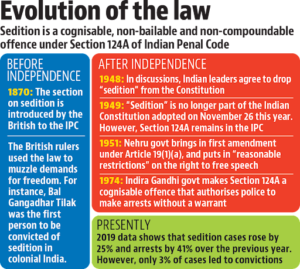In news– In the Supreme Court a plea challenged the constitutional validity of the sedition charge under Section 124A of the Indian Penal Code (IPC).
What is the issue?
- The pleas filed by the Editors Guild of India and Major General (Retired) S.G. Vombatkere state that the law causes a ‘chilling effect’ on free speech and is an unreasonable restriction on free expression, a fundamental right.
- The apex court had first issued a notice to the Centre in July 2021 about the challenge to the legality of Section 124A Indian Penal Code (IPC), which criminalises sedition.
- Later, on April 27, 2022, Supreme Court fixed May 5 for the final hearing of the petitions, stating that it will not bring any delay in the form of requests for adjournment.
What is Section 124A of IPC & Sedition law?
- It was drafted by British historian-politician Thomas Babington Macaulay in 1837.
- The Sedition charge, which was included in Section 124 A of the Indian penal code in 1870, was imposed by the British Colonial government to primarily suppress the writings and speeches of prominent Indian freedom fighters.
- The Indian Penal Code defines sedition (Section 124A) as an offence committed when “any person by words, either spoken or written, or by signs, or by visible representation, or otherwise, brings or attempts to bring into hatred or contempt, or excites or attempts to excite disaffection towards the government established by law in India”.
- Disaffection includes disloyalty and all feelings of enmity.
- However, comments without exciting or attempting to excite hatred, contempt or disaffection, will not constitute an offence under this section.
- The penal provision came in handy to muzzle nationalist voices and demands for freedom.
- The long list of India’s national heroes who figured as accused in cases of sedition includes Bal Gangadhar Tilak, Mahatma Gandhi, Bhagat Singh and Jawaharlal Nehru.
- Bal Gangadhar Tilak was the first person to be convicted of sedition in colonial India.
- The British government brought the charge alleging articles carried in Tilak’s Marathi newspaper Kesari would encourage people to foil the government’s efforts at curbing the plague epidemic in India.
- In 1897, Tilak was punished by the Bombay high court for sedition under Section 124A and was sentenced to 18 months in prison.
- Later, Section 124A was given different interpretations by the Federal Court, which began functioning in 1937, and the Privy Council, which was the highest court of appeal based in London.

- As per section 124A, sedition is a non-bailable offence, punishable with imprisonment from three years up to life, along with a fine.
- The person charged under this law is also barred from a government job and their passport is seized by the government.
- Incidentally, the sedition charge was abolished by the United Kingdom in 2010.
- According to Law Commission of India’s 2018 report, while framing the Constitution, the Constituent Assembly had opposed inclusion of sedition as a restriction on freedom of speech and expression under the then-Article 13.
- As per the Law commission the section 124A should be invoked only in cases where the intention behind any act is to disrupt public order or to overthrow the government with violence and illegal means.
The Sedition cases in the India-
- As per the 2020 National Crime Records Bureau (NCRB) report, in 2018, 70 sedition cases were filed; however, not a single person was convicted. Similarly, in 2019, 93 cases were filed, while only two were convicted. Similarly in 2020, 73 cases were filed and no one was convicted of sedition.
- Manipur filed the highest number of sedition cases (15) in 2020, followed by Assam (12), Karnataka (9), Uttar Pradesh (7), Haryana (6) and Delhi (5).
Court cases on this law-
- The validity of sedition law was tested for the first time in independent India by the then Punjab high court in 1951 in Tara Singh Gopi Chand Vs The State.
- The high court held that Section 124A was indisputably a restriction on the freedom of speech and expression, and invalidated the provision on the basis that it was in contravention of the fundamental right of freedom of speech and expression under Article 19 of the Constitution of India.
- But in 1954, the Patna high court, in Debi Soren & Ors Vs The State, upheld the validity of Section 124A, holding that the law does not violate Article 19.
- Four years on, the Allahabad high court declared Section 124A void in the case of Ram Nandan Vs State, and held that the government must be ready to face a strong opposition apart from popular approval or disapproval.
- The conundrum arising from various views of the high courts was finally settled by the Supreme Court by its judgment in Kedar Nath case in 1962, which is considered the most authoritative judgment of the Supreme Court on the interpretation of the sedition law.
- A Constitution bench upheld the validity of the sedition law under IPC, holding that the purpose of the crime of sedition was to prevent the government established by law from being subverted because “the continued existence of the Government established by law is an essential condition of the stability of the State”.
- At the same time, the five-judge bench defined the scope of Section 124A. It held that Section 124A only penalised words that reveal an intent or tendency to disturb law and order or that seem to incite violence.
















